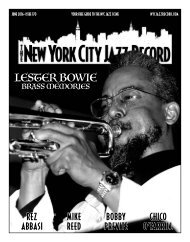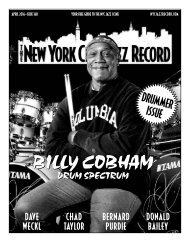Create successful ePaper yourself
Turn your PDF publications into a flip-book with our unique Google optimized e-Paper software.
E N CO RE<br />
DOUGLAS EWART<br />
by kurt gottschalk<br />
Douglas Ewart was likely not the name most known<br />
to the thousands of people at the Chicago Jazz Festival<br />
over Labor Day, but he made one of the strongest<br />
showings of the weekend. Besides delivering a set at<br />
once ebullient and thought-provoking, he wore a vivid<br />
red marching band coat with the letters “A-A-C-M”<br />
and the numerals “5” and “0” sewn onto the back, in<br />
what looked to be hand-cut felt.<br />
Even among followers of the Association for the<br />
Advancement of Creative Musicians (AACM), Ewart’s<br />
may not be the most recognized name among members<br />
of the seminal collective, which marked its 50th<br />
anniversary with concerts in its two bases of operations:<br />
Chicago, at the city’s annual jazz festival, and New<br />
York, as a part of its seasonal concert series. But if he<br />
hasn’t racked up an international reputation like Muhal<br />
Richard Abrams, Anthony Braxton, Roscoe Mitchell<br />
and some of the organization’s other acclaimed artists,<br />
the saxophonist and instrument-builder still has long<br />
been one of the most vocal champions of the cause. And<br />
despite having built a career that often takes him far<br />
from the concert stage, he continues to work with the<br />
musicians he met when he first encountered the AACM<br />
not long after its inception. “It’s one of the most<br />
amazing things about staying in the flow of things, as<br />
Roscoe says, when you build these relationships with<br />
kindred spirits and something comes of it,” he said.<br />
Born and raised in Kingston, Jamaica, Ewart grew<br />
up interested in music even if he wasn’t yet altogether<br />
pursuing it. “I made instruments out of tin cans,” he<br />
remembered. But, he added, he had nothing “in terms<br />
of having formal training or even having a drum kit,<br />
which is what I wanted to play.”<br />
His mother left for New York in hope of forging a<br />
better life when he was a child. Visa problems soon had<br />
her fleeing to Chicago, where she was able to find work<br />
and, eventually, legal residency. She sent for her son to<br />
join in 1963, when he was 17. At that time he was<br />
LEST WE FORGET<br />
GUNTHER SCHULLER<br />
by ken waxman<br />
During his long professional career Gunther Schuller,<br />
who died this past June and was born Nov. 22nd, 1925,<br />
was a French horn player, composer, conductor, author,<br />
university professor, record company and orchestra<br />
founder, festival administrator and conservatory<br />
president. But for certain segments of the music world<br />
he’s best-known for a term coined during a 1957 lecture<br />
at Brandeis University: “Third Stream”. While his idea<br />
of uniting the streams of jazz and classical music into a<br />
tributary melding influences from both was initially<br />
greeted with derision, nearly a half-century later<br />
crossover between the two is increasingly common.<br />
Schuller himself was an early example. Although<br />
he was playing French horn in his teens with the<br />
Cincinnati Symphony Orchestra and the Metropolitan<br />
Opera Orchestra (until 1959), he described himself as<br />
“a high school dropout without a single earned<br />
degree”. An interest in jazz, sparked by exposure to<br />
Duke Ellington’s orchestra, led eventually to<br />
participation in Miles Davis’ Birth of the Cool nonet<br />
sessions of 1949-50. Although thoroughly embedded in<br />
the notated side of the divide—“Of Reminiscences and<br />
Reflections”, one of his many compositions, won the<br />
considering a career as a tailor but he still had an<br />
interest in music and when a classmate took him to an<br />
early AACM concert he saw what would become his<br />
life’s pursuit. He befriended AACM members Fred<br />
Anderson and Joseph Jarman and at 21 had his first<br />
formal music lesson, studying saxophone at the AACM<br />
school on Chicago’s south side. Following the multiinstrumentalist<br />
mold of the organization, he soon<br />
added the flute and clarinet and, not long after that,<br />
returned to his old practice of making instruments out<br />
of salvaged materials. Inspiration wasn’t hard to find<br />
for the young musician. “There was a lot going on,” he<br />
said. “Coming from an island of relative quiet, the<br />
music was in foment. It was a powerful time, Coltrane,<br />
Eric Dolphy was still around. 63rd Street at that time<br />
was a bustling street with lots of theaters and<br />
nightclubs. Howlin’ Wolf was at a place called The<br />
Palace every week.”<br />
At the same time, the unrest of the era was leaving<br />
its mark on Ewart, who lived on the same block as<br />
Nation of Islam leader Elijah Muhammad. Political<br />
concerns continue to be a big part of Ewart’s music<br />
today. At the Chicago Jazz Festival, Ewart’s four<br />
singers called out the increasing number of reports of<br />
police using violence against civilians, intoning “Shoot<br />
him in the back, he’s black” alongside Sun Ra chants.<br />
And this month when he plays at Roulette, Ewart said<br />
he’ll present a piece addressing another problem<br />
besieging America. “I want to address some aspects of<br />
homelessness because it has become so ubiquitous<br />
throughout the country,” he said. “When I think of all<br />
the wealth and all the empty buildings in this country,<br />
it’s become so desperate.<br />
“One of the things that I’ve realized is that people<br />
who you think are really compassionate have difficulty<br />
giving money to people on the street,” he added.<br />
“I don’t know what they’re going to do with it and I<br />
can’t monitor that but I can, out of compassion, give<br />
somebody a few dollars. I think if we could see<br />
ourselves in those circumstances, we’d live in a<br />
different world.”<br />
Ewart left Chicago for Minneapolis in the ‘90s,<br />
moving with his wife who had been offered a job up<br />
north, but his connections to the city, and to the his old<br />
Pulitzer Prize for music in 1994—his association in the<br />
‘50s-60s with pianist John Lewis, music director of The<br />
Modern Jazz Quartet, helped put Third Stream ideas<br />
into practice. When MJQ recorded with expanded<br />
ensembles, Schuller usually conducted and, during a<br />
memorable New York concert in 1960, Bill Evans, Eric<br />
Dolphy, Jim Hall, Ornette Coleman and others<br />
improvised on Schuller’s Third Stream compositions<br />
such as “Variants on a Theme of Thelonious Monk”.<br />
Along with Lewis and Harold Faberman, Schuller also<br />
put these ideas into practice on a larger scale with<br />
Orchestra U.S.A. from 1962-65.<br />
Coleman had been introduced to the East Coast<br />
after he attended the Lenox School of Jazz in<br />
Massachusetts, which Lewis and Schuller initiated and<br />
oversaw from 1957-60. By that point Schuller had<br />
already taught at the Manhattan School of Music and<br />
at Yale from 1964-67. Aaron Copland recruited him for<br />
Tanglewood’s Berkshire Music Center and Schuller<br />
became its Artistic Director from 1969-84. Schuller’s<br />
ideas about jazz education came to fruition at the New<br />
England Conservatory (NEC) when he became its<br />
president from 1967-77. Not only did the venerable<br />
institution become the first major classical conservatory<br />
to grant jazz degrees, but he hired experienced jazz<br />
theorists like Jaki Byard and George Russell. With Ran<br />
Blake as its first chair, in 1972 Schuller also established<br />
NEC’s Third Stream department, now called the<br />
Contemporary Improvisation program.<br />
school, have remained strong. He has taught at the Art<br />
Institute of Chicago and has been a co-chair and<br />
corresponding secretary of the AACM. His commitment<br />
to the organization, which teaches self-expression and<br />
communal support, is unwavering. “It’s an integral<br />
part of my life,” he said plainly.<br />
Ewart has released some stellar records, but those<br />
have been few and far between. Much of his work<br />
simply doesn’t fit the recorded medium. His efforts<br />
often revolve around children and artistic expression—<br />
for example, dribbling a basketball to teach concepts of<br />
rhythm, counter-rhythm, soloing and composition. He<br />
holds an enduring fascination for the creative potential<br />
that can be found in spinning tops or medical crutches<br />
and for building environments where people can<br />
discover their own creative potential. His “Crepuscule”,<br />
for example, can involve as many as 400 people in a<br />
large, outdoor area—not just musicians but also<br />
dancers, painters, martial artists and doll-makers. As<br />
much a fair as it is a concert, it is orchestrated not for a<br />
listening audience so much as passers-by who decide<br />
to participate. Such projects may not have earned him<br />
a place on the shelves of record collectors, but they<br />
have been the building blocks of an unusual career.<br />
“Playing will always be close to my heart,” he said,<br />
“but I’m looking for other ways to engage myself and<br />
engage the communities I visit.” v<br />
For more information, visit douglasewart.com Ewart is at<br />
Roulette Dec. 10th as part of Interpretations. See Calendar.<br />
Recommended Listening:<br />
• George Lewis/Douglas Ewart—Jila-Save! Mon.:<br />
The Imaginary Suite (Black Saint, 1978)<br />
• Muhal Richard Abrams—Lifea Blinec<br />
(Arista Novus, 1978)<br />
• George Lewis—Homage to Charles Parker<br />
(Black Saint, 1979)<br />
• Douglas R. Ewart & Inventions—Newbeings<br />
(Aarawak, 2001)<br />
• Yusef Lateef/Roscoe Mitchell/Adam Rudolph/<br />
Douglas R. Ewart—Voice Prints (Meta, 2008)<br />
• Douglas R. Ewart & Inventions—Velvet Fire<br />
(Dedicated to Baba Fred Anderson) (Aarawak, 2009)<br />
Along with his other activities Schuller founded<br />
the New England Conservatory Ragtime Ensemble<br />
whose LP Joplin: The Red Back Book won a Grammy<br />
award for Best Chamber Music Performance in 1974. In<br />
1989 he conducted an all-star orchestral version of<br />
Mingus’ Epitaph, later released on record; and in 1990,<br />
after he and fellow jazz educator David Baker<br />
organized the Smithsonian Jazz Masterworks<br />
Orchestra, he programmed, conducted and recorded<br />
many infrequently performed jazz classics. In 1980 he<br />
founded the GM record label, which over the years has<br />
released discs featuring among others, his sons Ed, a<br />
bassist, and George a drummer. If that wasn’t enough<br />
Schuller wrote prose as well as music. Horn Technique<br />
is a standard reference for musicians while Early Jazz:<br />
Its Roots and Musical Development and The Swing Era:<br />
The Development of Jazz, 1930-1945 are considered<br />
essential works. v<br />
A Schuller tribute is at ShapeShifter Lab Dec. 12th. See Calendar.<br />
Recommended Listening:<br />
• John Lewis—Jazz Abstractions (Atlantic, 1960)<br />
• Eric Dolphy—Vintage Dolphy (GM, 1962-63)<br />
• Orchestra U.S.A.—Debut (Coolpix, 1963)<br />
• Charles Mingus—Epitaph (Columbia, 1989)<br />
• Joe Lovano—Rush Hour (Blue Note, 1994)<br />
• Gunther Schuller—Journey Into Jazz (Boston Modern<br />
Orchestra Project Sound, 1999/2002/2004)<br />
10 DECEMBER 2015 | THE NEW YORK CITY JAZZ RECORD




